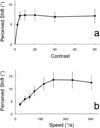The flash grab effect
- PMID: 23872166
- PMCID: PMC5047291
- DOI: 10.1016/j.visres.2013.07.007
The flash grab effect
Abstract
When an object moves back and forth, its trajectory appears significantly shorter than it actually is. The object appears to stop and reverse well before its actual reversal point, as if there is some averaging of location within a window of about 100 ms (Sinico et al., 2009). Surprisingly, if a bar is flashed at the physical end point of the trajectory, right on top of the object, just as it reverses direction, the flash is also shifted - grabbed by the object - and is seen at the perceived endpoint of the trajectory rather than the physical endpoint. This can shift the perceived location of the flash by as much as 2 or 3 times its physical size and by up to several degrees of visual angle. We first show that the position shift of the flash is generated by the trajectory shortening, as the same shift is seen with or without the flash. The flash itself is only grabbed if it is presented within a small spatiotemporal attraction zone around the physical end point of the trajectory. Any flash falling in that zone is pulled toward the perceived endpoint. The effect scales linearly with speed, up to a maximum, and is independent of the contrast of the moving stimulus once it is above 5%. Finally, we demonstrate that this position shift requires attention. These results reveal a new "flash grab" effect in the family of motion-induced position shifts. Although it most resembles the flash drag effect, it differs from this in the following ways: (1) it has a different temporal profile, (2) it requires attention, (3) it is about 10 times larger.
Keywords: Attention; Flash-drag effect; Motion; Position.
Copyright © 2013 Elsevier Ltd. All rights reserved.
Figures















References
-
- Anstis S. Kinetic edges become displaced, segregated, and invisible. In: Lam DM-K, editor. Neural mechanisms of visual perception, Proceedings of the Second Retina Research Foundation Conference. Texas: Portfolio Press; 1989.
-
- Baldo MV, Kihara AH, Namba J, Klein S. Evidence for an attentional component of the perceptual misalignment between moving and flashing stimuli. Perception. 2002;31:17–30. - PubMed
-
- Bregman AS. Auditory Scene Analysis: The Perceptual Organization of Sound. Cambridge, MA: The MIT Press; 1990.
-
- Cai RH, Schlag J. Temporal misalignment between continuous and abrupt changes. Sussex, UK: Meeting on visual location in space-time; 2002.
-
- Cai RH, Schlag J. Asynchronous feature binding and the flash-lag illusion. Investig. Ophthalm. & Vision Science. 2001;42:S711.
Publication types
MeSH terms
Grants and funding
LinkOut - more resources
Full Text Sources
Other Literature Sources

